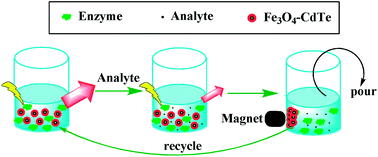Magnetic–fluorescent nanocomposites as reusable fluorescence probes for sensitive detection of hydrogen peroxide and glucose†
Abstract
Multifunctional nanoprobes with excellent reusable capability for practical detection can not only increase the resource utilization rate, but also reduce the discharge of toxic nanoparticles into the environment. In this paper, novel magnetic–fluorescent nanocomposites (Fe3O4@CdTe) have been successfully fabricated through layer-by-layer (LBL) self-assembly. The particles were used to develop a reusable fluorescence method to detect hydrogen peroxide and glucose with high sensitivity. The obtained core–shell Fe3O4@CdTe nanocomposites were characterized by transmission electron microscopy and fluorescence spectroscopy. The results indicated the successful formation of a CdTe shell on the surface of the magnetic Fe3O4 core. Its sensing performance towards H2O2 and glucose was then discussed in detail. The emission of the nanocomposites gradually reduced with the increasing analyte concentration. High sensitivity and good selectivity were observed from the composites. More importantly, these composites can be easily recovered and reused for several cycles due to their magnetism and high stability. Furthermore, we demonstrated that this fluorescent sensor can be used for glucose detection in human urine samples. As a multifunctional nanoplatform, the present nanoprobe holds genuine potential in future biosensing applications.


 Please wait while we load your content...
Please wait while we load your content...